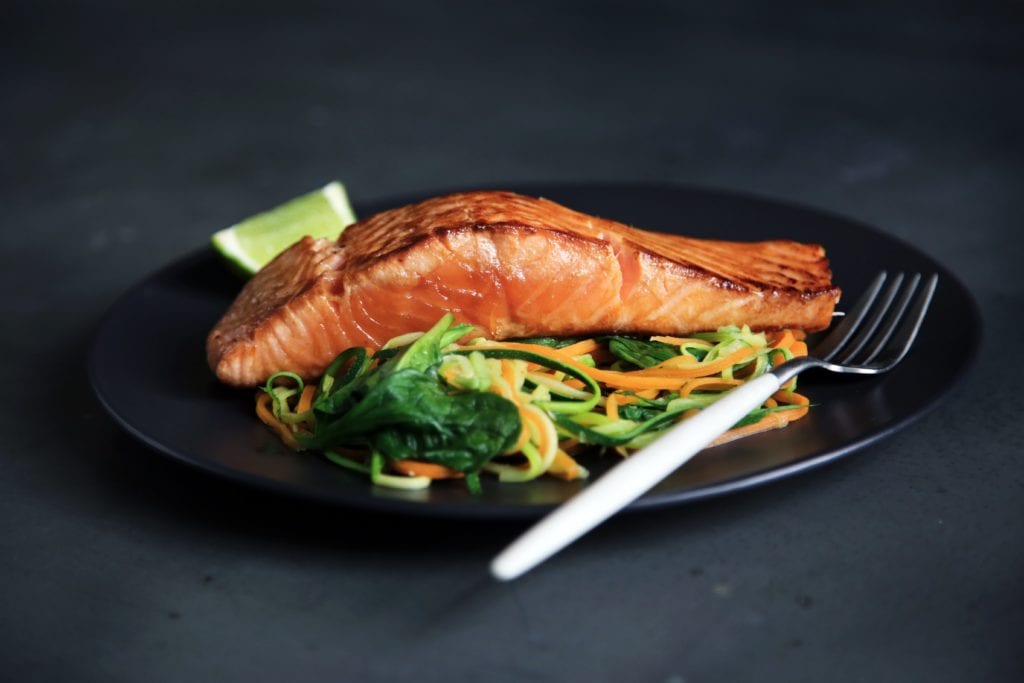Many people in the health and fitness world tend to take an extreme stance when it comes to consuming fat. Some believe dietary fat is automatically stored as body fat, and therefore eating low-fat foods will lead to weight loss. Others believe in adopting a ketogenic diet and that consuming 70% or more of their daily caloric intake from fat is the best route for optimal health. The two opposing stances have led to great skepticism and confusion toward the role fat should play in a healthy diet.
So the question remains: Does eating fat make you fat or does it fuel fat loss? The truth is, the answer is yes to both. While no studies have actually linked natural animal fats and plant-based fats to weight gain, it has been shown that regularly consuming processed, refined oils will lead your body to store excess fat. Let’s break down which fats are good and which fats are bad, so you can make the best dietary choices and reap the benefits of nourishing fats.
Good Fats
Let go of your fear of fat and start adding more good fats to your diet! These fats are essential for achieving optimal health as well as losing excess body fat. According to researchers at Washington University School of Medicine in St. Louis, “The ‘old’ fat stored in your body, especially around your belly, thighs or butt, cannot be burned efficiently without ‘new’ fat to help the process. Dietary fat helps break down existing fat by activating fat-burning pathways through the liver.”
Even more, in 2015, the Dietary Guidelines Advisory committee removed any recommendation of limiting dietary fat and cholesterol in its guidelines. Consuming dietary fat not only boosts your metabolism and increases fat burning, it also ensures you feel fuller longer, stabilizes your blood sugar levels, promotes better brain function, balances your hormones, increases your nutrient absorption from the food you eat and supports a healthy digestive system, among many other benefits.
Adopting a ketogenic diet is not mandatory to reap the many benefits of consuming dietary fat. Knowing the types of fat that fuel fat loss, as well as eating a balanced diet, will provide you with amazing health and fitness results. So which fats are considered “good”?
Good fats include organic extra-virgin olive oil, organic virgin coconut oil, flaxseed oil, sesame oil, avocado oil, avocados, olives, coconut butter, full-fat coconut milk, nuts and seeds (dry roasted or raw), nut and seed butters (no added sugar or processed oils), salmon, grass-fed meat, pasture-raised eggs, grass-fed ghee and grass-fed butter.

Bad Fats
The claim that “eating fat makes you fat” holds some truth. On one hand, good fats are required in the process of breaking down excess body fat, while on the other, bad fats promote fat storage.
The main sources of bad fat in our diet come from processed, refined oils, also known as hydrogenated oils, as well as trans fats. Hydrogenated oils and trans fats have been shown to damage your metabolism by putting a coating on your cells. This coating damages your cell receptors and stops you from burning calories like you normally would. These fats and oils also cause inflammation, leading to signs of aging, as well as greatly increasing LDL (bad) cholesterol levels.
Hydrogenated oils and trans fats have been scientifically engineered to be solid at room temperature and are found in most packaged foods, baked goods and fried foods. Unfortunately, that means they are found in your favorite coffee creamers, salad dressings, cereals, crackers, pretzels, chips and frozen dinners. Hydrogenated oils and trans fats come from margarine, canola oil, vegetable oil, sunflower oil, safflower oil, peanut oil, corn oil and cottonseed oil, to name a few.
Another way eating fat can lead to excess body fat is through eating too many fats high in omega-6 fatty acids. Omega-6s are required by your body in only small amounts. For optimal health, you must maintain a proper ratio between omega-6s and omega-3s. When you disrupt the ratio, you will cause your body to store excess body fat. According to the American Journal of Clinical Nutrition, the average American eats a omega-6 to omega-3 ratio of anywhere from 12:1 to 25:1, while many health experts recommend a ratio between 4:1 and 1:1. That’s a big difference!
Not only does an improper ratio promote weight gain, it causes inflammation in your body that leads to signs of aging, such as wrinkles and cellulite. The bad fats you should try to reduce in your diet include hydrogenated and partially hydrogenated oils, canola oil, vegetable oil, sunflower oil, safflower oil, peanut oil, corn oil, cottonseed oil, oil-roasted nuts, cooked olive oil, non-grass-fed meats and dairy products.
6 Tips for Eating Good Fats
1. Limit Omega-6 Fatty Acids and Processed Oils
Limit your omega-6 intake is by avoiding grain-fed meats and dairy products. Always look for grass-fed meats and, even better, the American Grassfed Association (AGA) seal on the package.
To avoid processed oils, which are also high in omega-6s, cook your own meals more often, as restaurants usually cook their food in canola, vegetable, soybean or peanut oil. What may look like a healthy grilled chicken salad most likely is smothered in one of these health-damaging oils. Limiting the amount of packaged foods you consume and focusing on cooking whole foods will also help reduce the omega-6s and processed oils in your diet.
When purchasing packaged foods, avoid these bad fats by looking at the list of ingredients before studying the nutritional facts. If something contains a bad fat, looking at the amount it contains is irrelevant. Just don’t buy it!
2. Cook with the Right Fats
Depending on the oils you cook with and the heat at which you cook them, you may be damaging your health. When oils exceed their smoke point, they become oxidized and rancid and release free radicals. Exposure to these free radicals greatly accelerates signs of aging, such as wrinkles, gray hair and loss of hair and skin elasticity.
The safest oils and fats for cooking include coconut oil, avocado oil and organic, grass-fed butter and ghee. They have a higher smoke point and are less likely to go rancid when cooking.
While olive oil provides countless health benefits, many health experts recommend not using it as your go-to cooking oil. Olive oil has a lower smoke point than the fats and oils listed above, and when cooked with, it will likely expose you to free radicals. Continue to include olive oil in your diet by adding it to your meal after it’s fully cooked.
Canola oil and vegetable oil are other common household cooking oils. Not only do these oils have a very low smoke point and are not suitable for cooking, they should be avoided in general.
![]()
3. Eat Your Vegetables with Fat
Depriving yourself of the right fats in your diet also deprives you of absorbing vitamins and minerals from your foods. Fat-soluble vitamins like A, D, E and K need the presence of fat in order to be absorbed by our bodies.
While eating a giant salad is extremely healthy, if eaten with a low-fat salad dressing or a salad dressing made from processed oils, your body will not absorb all of the essential nutrients it contains. Low-fat salad dressings can be packed with sugar or toxic chemicals and additives that increase fat storage. Dressings made from canola oil, vegetable oil, soybean oil or any similar processed oil with also slow your metabolism.
Pair your greens with a healthy oil and you will increase your nutrient absorption, stay much fuller longer and increase your fat burning.
4. Don’t Be Scared of Egg Yolks and Red Meat
Egg whites sound healthier, right? Actually, when you toss out the yolk, you are throwing out the most nutritious part of the egg. Just how eating fat doesn’t make you fat, cholesterol in eggs is not correlated to the cholesterol levels in your bloodstream. Eggs have the perfect balance of protein and fat, which will stabilize your hunger hormones and keep you feeling full and satisfied for hours. Don’t be scared—eat the whole egg!
Similarly, it has been disproven that there is a correlation between the saturated fat content in red meat and the risk of heart disease.
If you include red meat and eggs in your diet, buying the highest quality is worth the extra money if you want to reap the health benefits. When a cow or chicken is fed a grain-based diet, their meat or eggs contain a higher amount of omega-6 fatty acids and a lower amount of vitamins than grass-fed meat and pasture-raised eggs.

5. Increase Your Omega-3 Fatty Acid Intake
Try to include more omega-3s in your diet. Not only will it help you balance your omega-6 to omega-3 fatty acid ratio, it also helps regulate your blood sugar, decrease your stress hormone levels, promote lean muscle mass and fat loss, and reduce anxiety, inflammation and muscle soreness.
Flaxseed, chia seeds, fish (especially wild Alaskan salmon), walnuts, organic tofu, tempeh, navy beans, grass-fed beef, red lentils, wild rice and omega-3-enriched eggs and dairy products are a few omega-3-rich foods you can easily add to your meals in order to reach the proper ratio.
Most health experts recommend taking a daily high-quality omega-3 supplement to help keep your ratios in check.
6. Buy Real Olive Oil
An estimated 70% of olive oils found on store shelves are fake. These products have been mixed with lower-quality oils—usually canola, vegetable or soybean oil—making them cheaper to produce and sell. And as we already know, those hydrogenated oils should be avoided!
How do you know if an olive oil is fake? Generally, if the price is low, the quality is most likely low (although that is not always the case). Always look for cold-pressed extra-virgin olive oils, which have a darker color—if not, it’s most likely an oil blend. High-quality olive oils are often found in a darker-colored glass bottle, which prevents it from going rancid. Also, if you do a taste test, a real olive oil should create a weird feeling in the back of your throat or even make you cough.



I’m glad you highlighted that dressing made with naturals oils, like canola or olive oils, will reduce your metabolism. My boss invited us to eat at his favorite restaurant, but I’m on a diet. I’ll be sure to follow your suggestions by adding some fats to my salad.